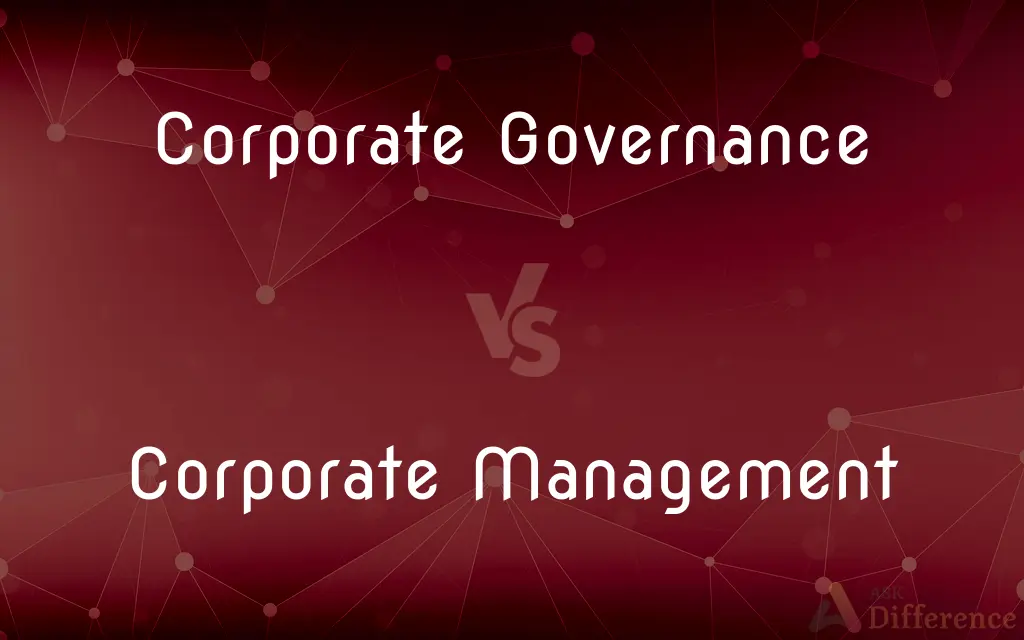Corporate Governance vs. Corporate Management — What's the Difference?
By Tayyaba Rehman — Published on October 4, 2023
Consignment involves sending goods to a third party to be sold, while Partnership denotes a business operation between two or more individuals sharing management and profits.

Difference Between Corporate Governance and Corporate Management
Table of Contents
ADVERTISEMENT
Key Differences
Consignment is a commercial arrangement where goods are shipped to a third party, referred to as the consignee, who subsequently sells these goods to end customers. Meanwhile, Partnership represents a business structure where two or more people collectively own and manage a business, sharing in the profits and losses. Each term thus embodies unique facets of business relationships, where consignment revolves around a product-based interaction and partnership leans towards shared management and financial dealings.
The focal point of Consignment is the transfer of goods to a consignee, with payment to the sender, or consignor, only occurring once the goods are sold. This transactional relationship doesn't imply shared ownership or joint business management, which is intrinsic to a Partnership, where all parties are collectively invested in the business operation, mutually navigating through its managerial and financial dimensions.
In a Consignment arrangement, the risk remains primarily with the consignor until the goods are sold, as they retain ownership of the items, while in a Partnership, all parties involved share the risks, responsibilities, and rewards of the business, collaboratively steering it towards its objectives. These dynamics highlight a critical distinction in risk distribution, where consignment localizes risk with the consignor and partnership diffuses it among all partners.
Consignment essentially segregates the roles of owning goods and selling them, where the consignor provides the items and the consignee facilitates the sale. Contrarily, Partnership mingles the roles of all parties involved, culminating in a singular entity that operates, manages, and assumes accountability for the business in unison. These distinct structures underline the dichotomy where consignment bifurcates roles based on ownership and sales, while partnership amalgamates all business facets among the partners.
Through Consignment, a consignor can expand market reach by leveraging the consignee's retail space or customer base without sharing ownership of the goods or the proceeds from their sale. Partnership, however, naturally implicates shared ownership, requiring all partners to entwine their resources, efforts, and expertise to nurture the business, embodying a holistic alliance rather than a segregated transactional relationship.
ADVERTISEMENT
Comparison Chart
Definition
Transfer of goods for sale, payment upon sale
Joint business ownership and management
Ownership
Retained by consignor
Shared among all partners
Risk
Borne by consignor until sale
Distributed among all partners
Profit Distribution
Not shared, paid to consignor after sale
Divided among partners per agreement
Legal Entity
Not a separate legal entity
Can be a separate legal entity depending on jurisdiction
Compare with Definitions
Corporate Governance
Goods sent to be sold, retaining ownership until sale.
The consignor lost no money as unsold Consignment items were returned.
Corporate Management
An alliance where business responsibilities and gains are shared.
In their Partnership, each partner brought unique expertise to the table.
Corporate Governance
Sending goods to be sold, without transferring ownership.
His products gained visibility through Consignment at retail stores.
Corporate Management
A collective business endeavor involving shared risk and reward.
The Partnership encountered challenges but prevailed through collaborative problem-solving.
Corporate Governance
Shipment of goods for sale, with payment upon sale.
The boutique sold dresses on Consignment from various designers.
Corporate Management
A business entity formed by two or more individuals.
Their Partnership thrived due to shared goals and complementary skills.
Corporate Governance
An agreement where payment is rendered upon sold goods.
Through Consignment, her crafts reached a wider customer base.
Corporate Management
Collaborative business operation and financial investment.
Their Partnership fostered innovation and resourceful business solutions.
Corporate Governance
A transaction where goods are sold by a third party.
The artist sent a Consignment of paintings to the gallery.
Corporate Management
Joint business ownership with shared management and profits.
Through Partnership, they launched a successful restaurant chain.
Common Curiosities
Who bears the risk in a Consignment?
The consignor bears the risk in Consignment as they retain ownership of goods until they are sold.
How are profits distributed in a Partnership?
Profits in a Partnership are typically distributed among the partners based on an agreed-upon ratio or percentage.
Is the consignee responsible for unsold goods in Consignment?
Generally, no. Unsold goods in Consignment are typically returned to the consignor.
What defines a Partnership in business?
A Partnership is a business structure where two or more individuals own, manage, and share the profits and losses of a business.
What does Consignment involve?
Consignment involves sending goods to a third party (consignee) to be sold, with payment to the sender (consignor) occurring upon sale.
Share Your Discovery

Previous Comparison
Qualitative Research vs. Quantitative Research
Next Comparison
Blinking vs. FlickeringAuthor Spotlight
Written by
Tayyaba RehmanTayyaba Rehman is a distinguished writer, currently serving as a primary contributor to askdifference.com. As a researcher in semantics and etymology, Tayyaba's passion for the complexity of languages and their distinctions has found a perfect home on the platform. Tayyaba delves into the intricacies of language, distinguishing between commonly confused words and phrases, thereby providing clarity for readers worldwide.












































